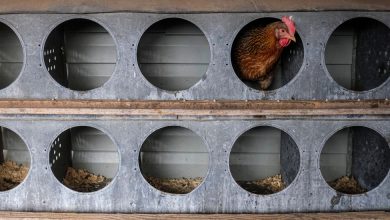Meet Stiltgrass, Your New Garden Adversary

Have you had the displeasure of meeting stiltgrass?
Shortly after S. Luke Flory began researching the ecology of the invasive species Microstegium vimineum as part of his doctorate at Indiana University, he wanted to get the word out about what he was learning.
It was around 2004, and awareness was dawning that stiltgrass had become a widespread invader, rapidly colonizing habitats throughout the eastern United States and displacing native plant populations. This prompted a scramble for solutions.
“I pushed hard for people to understand the biology and ecology of the species in relation to possible control methods,” said Dr. Flory, now a professor of ecology at the University of Florida, who has published more than 35 papers on Microstegium.
Without knowledge of the life history of an invasive plant — especially one so tenacious — he knew there could be little hope of limiting its spread.
Every weedy species has its stroke, or strokes, of genius — its strategy for success.
One common characteristic: deep, fleshy roots. The roots of field bindweed (Convolvulus arvensis) may go down 20 feet or more. Some roots make matters even worse, excreting chemicals that prevent other plants from getting established. This kind of plant warfare, known as allelopathy, is exhibited by weeds like garlic mustard (Alliaria petiolata).
Sowing lots of seed is another common tactic. A large purple loosestrife plant (Lythrum salicaria)can produce 2.7 million in a single season. Seeds that remain viable in the soil over long periods of time, like those of common mullein (Verbascum thapsus), can overtake the competition for a century — and outlive the exhausted gardener or land manager.
“I’m not going anywhere anytime soon,” such strategies seem to say.
So what characteristics have enabled the success of stiltgrass?
The Ways of Stiltgrass
“Don’t call it Japanese stiltgrass,” Dr. Flory said of the weed’s frequently used common name, as it is native to other parts of Asia, too, including China, India, Korea and Malaysia.
How did a grass that arrived in the United States about a century ago, possibly as packing material in crates of porcelain, make its way to sites as far-flung as the Florida Panhandle, New England, Michigan and Missouri?
As much as we know about Microstegium’s biology and ecology, questions remain.
Stiltgrass displays exceptional adaptability to a variety of regions and habitats, establishing itself along river and stream banks, in forests, and along roads and trails. It grows in full sun, in less than 10 percent ambient light and in various degrees of soil moisture.
It is an annual grass, and a warm-season grower — meaning that this year’s crop doesn’t start germinating until well into spring, unlike, say, chickweed (Stellaria media) or other cool-season annual weeds.
When stiltgrass is small, Dr. Flory said, it “looks like tiny bamboo.”
By summer, you may see it in fuller form along the roadside, or maybe in your garden or lawn. And it may just register as “grass.” But look closer: The lance-shaped leaves alternate down the stems, and a silvery line often runs lengthwise near the center of each older leaf.
Although it can grow taller and may sprawl, stiltgrass is usually in the one- to three-foot range. In winter, plants that have died back will blanket the ground in a tan or orange layer of thatch.
Another tip-off: “You’re usually not going to find just one or two individual plants,” Dr. Flory said. Stiltgrass almost always grows densely.
No wonder, as each plant produces hundreds of seeds. And the seed doesn’t just fall in place: It can float or move downstream on currents and in floods. It can also be tracked from place to place by vehicles, foot traffic and other human activities.
The Limits of Mowing
Angela Sirois-Pitel, the stewardship manager for the Nature Conservancy in Massachusetts, has been focused on managing stiltgrass for about a decade, on conservancy lands in the Southern Berkshires.
“It’s been my first time managing an annual grass, which is very different from the usual big barberry shrubs,” she said, referring to a common invader of woodland edges, fields and roadsides in the area.
The conventional wisdom with unwanted annuals: Prevent them from ripening and sowing their next generation of seed, perhaps by hand-pulling — or, on a scale like Ms. Sirois-Pitel’s, with well-timed mowing. Once whatever seed remains in the soil from past years is no longer viable, the thinking goes, you will have reduced, if not eliminated, your problem.
Stiltgrass seed remains viable for at least three years (some research suggests up to five). To time the mowing just right, careful monitoring was required, Ms. Sirois-Pitel said. Her team examined each population from July onward, so they could mow after flowering had begun, but before the seed was set.
But while the seed lacks the staying power of a common mullein, she found that it resisted years of mowing around late August, with follow-ups to knock back any re-sprouted or reseeded area in September.
Mowing was maybe “holding the line,” Ms. Sirois-Pitel said. “After 10 years, populations weren’t as robust — but we weren’t eradicating it.”
Besides producing lots of seed, stiltgrass has another superpower: its mixed-mating system. Dr. Flory suspects that may play a role in its resistance to being subdued by mowing.
How it works: Stiltgrass has two kinds of flowers. The more obvious ones are open and sit at the tips of stems in early fall. These chasmogamous flowers can cross-pollinate to make seed. A second group of flowers is borne on the leaf axils, where the top of the leaf meets the stem. These are cleistogamous: They do not open, but self-pollinate and set seed.
Because they are lower down on the plant, Dr. Flory wonders, do they escape the full impact of mowing? More research may confirm that hypothesis.
But there’s another drawback to mowing about which there is certainty: It isn’t selective. Everything in the mower’s path is beheaded, including adjacent natives, so it’s not suited to all situations.
A Gardener’s Plan of Attack
Stiltgrass has escaped many of its natural enemies in its new homelands, another advantage that alien invaders often display. Deer don’t eat it, nor is it an insect favorite.
For a while, a naturally occurring fungal pathogen that infects the plant seemed to show promise as a natural biological control.
“Scientists hoped that disease from this pathogen would suppress invasive populations,” Dr. Flory said. “But our latest research indicates that instead, pathogens accumulating on Microstegium may spill back to native species and enhance the impact of the stiltgrass invasion.”
The decision to use herbicides is not an easy one for a land manager. But the large-scale threat that stiltgrass poses by disrupting ecosystems and wildlife habitats is too great, and the mechanical controls that Ms. Sirois-Pitel implemented weren’t having enough of an effect to allow native species to rebound — the end goal.
With the targeted use of herbicides in July, she has seen much better results: a 50 to 80 percent reduction in the stubborn populations of stiltgrass.
“And we are getting good native recruitment in those areas,” she said. Plants that had been crowded out are returning, including some ferns, grasses and goldenrods, and more seedlings of maples, oaks and hemlock.
For gardeners, she recommends starting by hand-pulling the weed before it flowers and sets seed (in late July or early August, in regions similar to hers), with diligent repetitions. Fortunately, one weedy feature that stiltgrass doesn’t have is 20-foot-deep fleshy roots; its root system is shallow and easy to dislodge.
Unless your stiltgrass invasion is minor and can be managed by hand, Ms. Sirois-Pitel recommends consulting a habitat-management professional — especially before considering any form of chemical control.
“Don’t assume you can go to the hardware store, buy something and use it and get results,” she said. Get advice, even if you don’t plan to hire someone to perform any work.
A pesticide-licensed expert with an ecology background will consider the other plants involved and other factors on the ground, recommending the most effective, conservative strategy. Some grass-specific herbicides, for example, could target stiltgrass and leave broad-leaved species and regenerating trees intact, although they typically can’t be used near wetlands.
So what does stiltgrass have in mind going forward?
Dr. Flory has noticed that populations establishing themselves farther north, in locations like upstate New York, have evolved quickly to a shorter growing season, completing their life cycle by setting seed much faster than populations in Southern states like South Carolina.
“It’s biologically super-interesting, I think,” he said.
He paused before sharing what that observation has him wondering about: “It suggests that the potential range of invasion is much larger than what it is now.”
Margaret Roach is the creator of the website and podcast A Way to Garden, and a book of the same name.
For weekly email updates on residential real estate news, sign up here. Follow us on Twitter: @nytrealestate.





